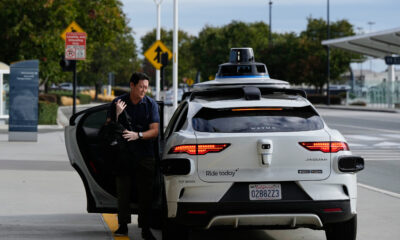Tech
How Pacific nations plan to go from spending up to 25% of GDP on fossil fuels to running on 100% renewables

Picture dusk falling somewhere in the Solomon Islands. A fisher’s skiff glides home using a whisper-quiet electric outboard motor. In the Cook Islands, a big battery steadies the island grid. In Papua New Guinea’s highlands, solar kits bring electric light to homes for the first time.
These aren’t prototypes—they’re already up and running across the Pacific. Put together, these stories of quiet change point to something bigger.
For decades, Pacific island countries have led the global fight on climate change. These nations are highly exposed to the damage from rising sea levels, acidifying oceans and bleached coral reefs. Pacific leaders helped secure the 2015 Paris Agreement and the global goal of holding warming to 1.5°C.
Now the Pacific is leading the way again. Island leaders have a bold plan to become the world’s first region powered entirely by renewables and energy storage.
The move isn’t symbolic. It’s extremely practical. Pacific nations spend an eye-watering percentage of their GDP (10%–25%) buying fossil fuels to run power plants, generators and vehicles. Ending reliance on imports and becoming energy independent will bring major dividends. Despite widespread support, the Pacific’s clean energy transition has not yet taken off in earnest due to transport costs and gaps in financing, skills and regulation.
Leaders will formally release a renewable roadmap next week at the COP30 climate conference in Brazil. Pacific nations and Australia are bidding to host the next climate talks in 2026. Island leaders hope to leverage the global summit to attract investment in their own energy transition.
Slashing fossil fuel imports will save billions
Right now, Pacific countries spend A$9–$14 billion a year importing diesel for generators and fuel for vehicles and boats.
Sharp falls in renewable costs mean solar and battery systems are now clearly cheaper than fossil fuels for electricity generation.
Even with the Pacific’s logistical challenges, installed costs for solar have fallen more than five-fold since 2010. The cost of grid-scale and home batteries is falling quickly.
Replacing diesel generation with solar and batteries would cost an estimated $3–$4 billion. These costs would be quickly recouped, given annual savings would be around $610–$840 million.
The biggest challenge will be financing for large-scale renewables, grid infrastructure and energy storage. Many outer islands can move ahead faster by replacing diesel generators with solar and batteries. A rapid shift to electric vehicles (EVs) and vessels is also possible. Government incentives have triggered rapid uptake of EVs and hybrids in Fiji. Electric outboard motors are also ready for prime time.
Cost savings would free up funds for essential infrastructure, health, education and climate resilience. Renewables represent a powerful development strategy for the Pacific.
Global renewable uptake is key to survival for Pacific nations
Individual Pacific countries have set ambitious renewable energy targets in national commitments under the Paris Agreement. Fiji plans to be powered 100% by renewables by 2035, while Tuvalu is aiming to get there by 2030.
These national goals can contribute to a regional target for 100% renewable energy. Pacific leaders have agreed to establish a Pacific Energy Commissioner to coordinate the transition.
Pacific island countries are not major polluters, contributing just 0.02% of global emissions. Cutting the region’s emissions will do very little to limit warming.
The importance of this new plan is showing 100% renewables is now doable.
As Vanuatu climate and energy minister Ralph Regenvanu states: “If we can manage the rapid transition of our energy systems in the Pacific Islands, it can be a beacon for the rest of the globe. Our survival depends on it.”
Holding warming to 1.5°C is critical for low-lying atoll nations. Climate resettlement is already under way, as Tuvalu residents enter ballots to move to Australia while Fijian villages are relocating to higher ground.
Two years ago, nearly 200 countries agreed to triple global renewable capacity and accelerate the transition away from fossil fuels. Reaching this goal is crucial to keep 1.5°C within reach. Pacific nations can show the way. But their survival isn’t in their hands—it depends on the world following suit.
Next year’s climate talks could drive the change
For several years, Pacific nations and Australia have been bidding to host the 2026 COP31 climate summit. But Turkey has a rival bid. A final decision is expected next week.
As Palau President Surangel Whipps has said, hosting COP31 in the Pacific cannot just be about symbolism—it must demonstrate “tangible benefits” to Pacific peoples.
If the joint bid for COP31 gets up, Pacific leaders will be pressing for progress on their 100% renewable plan by seeking investors and technology partners.
The COP talks are more than climate negotiations—they’ve become the world’s biggest trade fair. Thousands of delegates will be looking to invest in renewable energy. More than 70% of investment in renewables in Australia comes from abroad and COP31 could attract finance for both Australia and the Pacific.
Palau will host regional leaders next year at the annual Pacific Islands Forum leaders’ meeting. Whipps, the incoming chair, will focus on building a regional renewable Pacific partnership and is planning an investment meeting next year to help attract international investment ahead of COP31.
Some investment is likely to come from Australia, both private and public. Australia is rapidly replacing coal-fired power with renewables and storage at home and is already supporting Pacific clean energy projects. But Pacific leaders have also called on Australia to “stop approving new gas and coal projects” and stop subsidizing fossil fuel production.
The Pacific’s plan to run on clean power makes clear sense on financial, energy security and climate leadership grounds. The question now is—will it happen?
This article is republished from The Conversation under a Creative Commons license. Read the original article.![]()
Citation:
How Pacific nations plan to go from spending up to 25% of GDP on fossil fuels to running on 100% renewables (2025, November 13)
retrieved 13 November 2025
from https://techxplore.com/news/2025-11-pacific-nations-gdp-fossil-fuels.html
This document is subject to copyright. Apart from any fair dealing for the purpose of private study or research, no
part may be reproduced without the written permission. The content is provided for information purposes only.
Tech
$25 Off Exclusive Blue Apron Coupon for November 2025

We’ve been testing (aka eating) Blue Apron for our guide to the best meal kit subscriptions for nearly half a decade.The Gear team likes this service so much, it has its own story. If you’ve been struggling with figuring out what to make for dinner, you can save some money on our top service right now using a Blue Apron coupon or deal featured right here on WIRED.
Unlock $25 Off With Our Exclusive Blue Apron Promo Code
Blue Apron makes it easy—new customers can enjoy $100 off for the first five weeks of a new subscription—plus the first week ships free). Blue Apron is offering discounts of up to $4 per serving, depending on whether you opt for 4, 6, 8, or 10 meals per week. WIRED readers get rewarded—in discounts on delicious food—with $25 off your first 2 orders with promo code CONDE25, until August 11 2026. There’s also other deals for 20% off your first 2 orders with code WELCOME20, 25% off with code WELCOME25 at checkout, and up to 50% off your first 2 orders with promo code ORDER50, no subscription needed. Check out Blue Apron and see if it’s the right meal kit service for you, and from there you’ll be able to claim the deal with either promo code, and both codes are valid site wide.
Get a 5% Off Blue Apron Coupon With Autoship and Save
Apron now offers an Autoship & Save program, which includes a 5% off discount on every order for autoship. Be sure to download the Blue Apron app, which allows you to easily manage subscriptions, get notifications, and live delivery updates through your phone. With Autoship & Save, you’ll set up recurring deliveries on a schedule that works for you, and you can save 5% on every order. This includes setting your own schedule, including how often you want deliveries and what day of the week you want them. Plus, you can always skip a delivery if you don’t need it that week. To get started, you just need to choose your menu items from a wide range of options, and every order is pre-filled with meals Blue Apron recommends, but you can always add, swap, or remove anything before it ships out.
Explore Blue Apron’s New Meal Kit Options From $7
If you’re a commitment-phobe like me and don’t want to sign up for pricey recurring orders in the subscription model before trying, we have good news. Unlike almost all other meal kits and delivery services, Blue Apron just updated their model to include a la carte meal kits and ready-to-eat meals that don’t require a recurring plan. You can get delivery in as little as three days, and it requires no commitment or mandatory subscription.
Meal Kits include step-by-step recipes and pre-portioned food, from $7 to $13 per serving. Easy ‘Assemble & Bake’ meals require minimal prep and are $11 to $13 per serving, and ‘Dish by Blue Apron’ are ready to eat, heat-and-serve meals from $9 to $12 per serving. They’ve also expanded their menu with new recipes, now with over 100 meals to choose from.
Score 20% Off Blue Apron+ or Start a 30-Day Free Trial
Blue Apron now also has a membership program, where for $10 per month, you’ll get free shipping on all orders, unlimited Tastemade+ streaming (this includes food, home and travel shows, a $50 value), and exclusive deals promotions throughout the year. If the bonus promos seem like something you’d use, the membership program is a good deal, because delivery is already $10 per month, so you’re getting free shipping plus all of these extra goodies. If you’re unsure, you can try it out with a 30 day free trial, just follow the link here. The good news is that you can get 20% off an annual Blue Apron+ membership, now at $80 per year instead of $100.
Save up to 50% With Blue Apron Heroes Discounts
Blue Apron wants to reward our everyday heroes, and has discounts for Military members, Students, Graduates, Teachers, Seniors, Medical Staff, and First responders. Members of these groups can get $150 off the first five weeks of a new subscription, plus free shipping for the first week of subscriptions. To get this discount, you’ll need to verify through ID.me or GovXID.
How to Make the Most of Your Blue Apron Subscription
Blue Apron makes it easy to customize your meal plan to fit your lifestyle, with new rotating menus released every week. Choose from vegetarian, carb-conscious or protein-packed options, and adjust portions or skip weeks as needed. You can even add extras like appetizers or desserts for a complete dining experience. Simply pick out your plan—you can choose how many meals you want per week and select your choice from the Mediterranean-style weekly menus. Pick your veggie- and protein-forward meals, enter your shipping information, and get ready to get cookin’. And if you don’t really want to cook at all, check out the Prepared & Ready meals for heat-and-eat options. Going on vacation? It’s easy to skip, pause, change, or cancel your plan right from your account online. Head over to their site to explore all of their options and save with a Blue Apron coupon.
Tech
Robots trained with spatial dataset show improved object handling and awareness

When it comes to navigating their surroundings, machines have a natural disadvantage compared to humans. To help hone the visual perception abilities they need to understand the world, researchers have developed a novel training dataset for improving spatial awareness in robots.
In new research, experiments showed that robots trained with this dataset, called RoboSpatial, outperformed those trained with baseline models at the same robotic task, demonstrating a complex understanding of both spatial relationships and physical object manipulation.
For humans, visual perception shapes how we interact with the environment, from recognizing different people to maintaining an awareness of our body’s movements and position. Despite previous attempts to imbue robots with these skills, efforts have fallen short as most are trained on data that lacks sophisticated spatial understanding.
Because deep spatial comprehension is necessary for intuitive interactions, if left unaddressed, these spatial reasoning challenges could hinder future AI systems’ ability to comprehend complex instructions and operate in dynamic environments, said Luke Song, lead author of the study and a current Ph.D. student in engineering at The Ohio State University.
“To have true general-purpose foundation models, a robot needs to understand the 3D world around it,” he said. “So spatial understanding is one of the most crucial capabilities for it.”
The study was recently given as an oral presentation at the Conference on Computer Vision and Pattern Recognition. The work is published in the journal 2025 IEEE/CVF Conference on Computer Vision and Pattern Recognition (CVPR).
To teach robots how to better interpret perspective, RoboSpatial includes more than a million real-world indoor and tabletop images, thousands of detailed 3D scans, and 3 million labels describing rich spatial information relevant to robotics. Using these vast resources, the framework pairs 2D egocentric images with full 3D scans of the same scene so the model learns to pinpoint objects using either flat-image recognition or 3D geometry.
According to the study, it’s a process that closely mimics visual cues in the real world.
For instance, while current training datasets might allow a robot to accurately describe a “bowl on the table,” the model would lack the ability to discern where on the table it actually is, where it should be placed to remain accessible, or how it might fit in with other objects. In contrast, RoboSpatial could rigorously test these spatial reasoning skills in practical robotic tasks, first by demonstrating object rearrangement and then by examining the models’ capacity to generalize to new spatial reasoning scenarios beyond their original training data.
“Not only does this mean improvements on individual actions like picking up and placing things, but also leads to robots interacting more naturally with humans,” said Song.
One of the systems the team tested this framework on was a Kinova Jaco robot, an assistive arm that helps people with disabilities connect with their environment.
During training, it was able to answer simple close-ended spatial questions like “Can the chair be placed in front of the table?” or “Is the mug to the left of the laptop?” correctly.
These promising results reveal that normalizing spatial context by improving robotic perception could lead to safer and more reliable AI systems, said Song.
While there are still many unanswered questions about AI development and training, the work concludes that RoboSpatial has the potential to serve as a foundation for broader applications in robotics, noting that more exciting spatial advancements will likely branch from it.
“I think we will see a lot of big improvements and cool capabilities for robots in the next five to ten years,” said Song.
Co-authors include Yu Su from Ohio State and Valts Blukis, Jonathan Tremblay, Stephen Tyree and Stan Birchfield from NVIDIA.
More information:
Chan Hee Song et al, RoboSpatial: Teaching Spatial Understanding to 2D and 3D Vision-Language Models for Robotics, 2025 IEEE/CVF Conference on Computer Vision and Pattern Recognition (CVPR) (2025). DOI: 10.1109/cvpr52734.2025.01470
Citation:
Robots trained with spatial dataset show improved object handling and awareness (2025, November 13)
retrieved 13 November 2025
from https://techxplore.com/news/2025-11-robots-spatial-dataset-awareness.html
This document is subject to copyright. Apart from any fair dealing for the purpose of private study or research, no
part may be reproduced without the written permission. The content is provided for information purposes only.
Tech
Jeffrey Epstein Claimed Intimate Knowledge of Donald Trump’s Views in Texts With Bill Gates Adviser

The next day, she sent Epstein a link to an article in Commentary about Trump’s election and the American economy. “Good article for trump to see,” she wrote.
On March 4, Melanie messaged Epstein. “Bg meets w trump march 20/21,” in apparent reference to Gates. (Gates did indeed meet with Trump at the White House on March 20, 2017. Sean Spicer, the White House press secretary, said the meeting was about combatting disease outbreaks around the world.)
“A waste of time,” replied Epstein. “he should meet with barrack,” in an apparent reference again to the current US ambassador to Turkey.
On March 6, Epstein and Melanie continued messaging about Trump and Gates.
“Israel – tell bill Paris week of 21,” Epstein wrote, in apparent reference to a supposed peace meeting regarding the situation in the Middle East.
“Peace mtg? W Jared and Tony Blair and all those folks? Not sure bg interested in peace process mostly technologies,” replied Melanie. “He says he speaks to Jared a lot”
“No peace boring and not happening. GROW UP,” Epstein replied.
(While there didn’t appear to be a peace meeting in Paris in March 2017, on March 10, days after these messages were sent, Trump had his first ever phone call with Palestinian leader Mahmoud Abbas and invited him to visit the White House.)
In their messages on March 6, Melanie reminded Epstein that the meeting was taking place between Gates and Trump later that month.
Epstein appeared to then claim a meeting was taking place at his house to discuss a myriad of issues related to Israel, including, he said in a message to Melanie, “Money surveillance, offense. It’s at my house so I would know.” It’s unclear if the meeting took place, or who attended if it did.
“Omg INVITE ME,” writes Melanie. “Can try to invite bg depending on guest list etc – Larry told him he couldn’t have contact w you so would have to manage that carefully.” (This is an apparent reference to Larry Cohen, Gates’ longtime associate. Cohen is the CEO of Gates Ventures and did not reply to a request seeking comment.)
“Not a problem for me,” writes Epstein. “I like bill . He gets more from me than I get from him. He should grow some balls and start to love.”
-

 Entertainment6 days ago
Entertainment6 days agoChina unveils£5.4 bn Fujian, its most advanced aircraft carrier yet
-

 Business1 week ago
Business1 week agoGST rationalisation impact: Higher RBI dividend expected to offset revenue shortfall; CareEdge flags tax pressure – The Times of India
-

 Tech1 week ago
Tech1 week agoBlood Tests for Alzheimer’s Are Here
-

 Business1 week ago
Business1 week agoSetback for expatriates? Delhi HC upholds mandatory EPFO membership; what this means for foreign staff – The Times of India
-

 Fashion1 week ago
Fashion1 week agoBangladesh Bank allows foreign currency-taka swap facility for dealers
-

 Tech1 week ago
Tech1 week agoThe AI Data Center Boom Is Warping the US Economy
-

 Politics1 week ago
Politics1 week agoTrump links Republicans’ election setbacks to record US govt shutdown
-

 Tech1 week ago
Tech1 week agoZohran Mamdani Just Inherited the NYPD Surveillance State


















